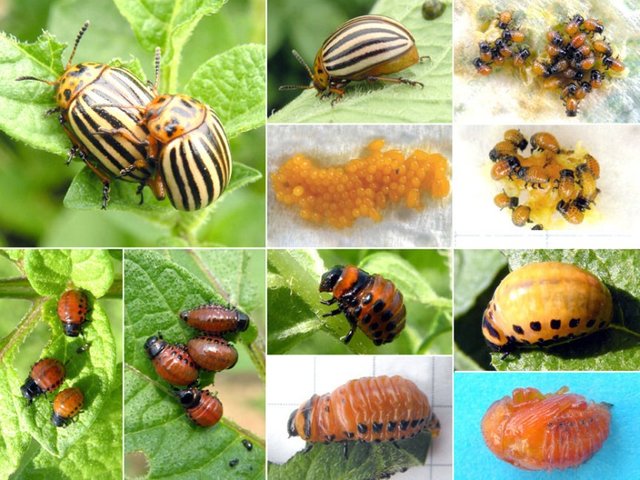This is my theme for Saturday: The potato beetle
Potato beetle or Doriphora. (Leptinotarsa decemlineata). It is a coleoptera belonging to the family of the Chrysomelidae, associated with the places of cultivation and storage of potatoes, on which it acts as a pest.
Morphological characteristics
Its body is protected by a shell formed by the elytra, which protect the wings of flight, the abdomen, the thorax and the head, the legs and the antennas have various forms, The potato beetle have composite metamorphosis and requires long time for its development, the larva is born a month after laying, but remains inside the earth for four summers, after this period it becomes an adult insect.

Source
This well-known potato beetle, measuring about 10 x 6 mm, has a robust, oval body, strongly convex and hardened. It is easily distinguished by its yellowish brown color on which 5 black longitudinal bands stand out on each elytra; it also has a dozen small black spots on the top of the head and thorax and other dark brown or black spots on the ends of the legs; its coloration uses it to warn predators of its ability to secrete a repellent substance.
Potato beetle habitat
The annual cycle of the potato beetle begins in early spring or early summer, when, depending on the climate and the physiological state, the beetles that spent the winter buried emerge from the ground; This emergency is usually massive and occurs in 1 or 2 days. The beetle then makes a flight to its food, usually a potato garden, where it feeds; the activity is optimal at about 25 ºC.
Crops that attacks the potato beetle
The plants most attacked by this insect are potatoes (Solanum tuberosum), eggplant (Solanum melongena), tomato (Lycopersicon esculentum), cabbage (Brassica oleracea) and others.
The potato beetle is one of the most destructive and widely distributed pests of potato cultivation. Adults and larvae feed on this plant and often cause complete defoliation with considerable yield losses (50% of the crop in some countries). Moreover, this insect also contributes to the dispersal of several potato diseases, including the wilt of the solanaceae produced by Pseudomonas solanacearum, and the annular rot of the potato that causes Clavibacter michiganensis.
his coleoptera insect can also cause damage to tomato and eggplant plants. Both larvae and adults feed on the leaves and can completely eliminate the plants. Insecticides are currently the main method of control of this beetle in commercial plantations. However, many insecticides do not produce a good result in their control due to the toxic resistance of this species and the rapidity with which they can develop resistance to them. This species has developed resistance to most of the insecticides normally used.
How to control the potato beetle?
The great fecundity of this species usually helps it to withstand the pressure of its natural enemies. Even so, in certain cases, their natural enemies can keep populations of L. decemlineta low, so that the economic damage caused is not high.
Biologic control:
The most effective method to combat the potato beetle is Bacillus thuringiensis, a biological treatment (since Bacillus is a bacterium) for use in organic agriculture and horticulture, which leaves no residues or harms useful fauna (such as bees).
Fumigations: Fumigate all the plants with a preparation with the orange peel and the leaves of the neem plant, all these ingredients are boiled then they are passed through a sieve and ready.
Chemical control: Fumigate the plants with insecticides based on cypermethrin.
How to prevent the potato beetle from the ecological garden.
To prevent these beetles from sunning the potatoes in your garden, you can use some natural methods to control their appearance:
- Perform rotations in potato crops in the garden, especially if you have had potato beetle plague last season.
- Do not re-plant your potatoes in the same space where you had them last year. Some specimens can spend the winter on the ground and when spring arrives they will attack your potatoes or aubergines again. However, if they find another crop they can not feed on, they will die of hunger.
- Eliminates the first adults detected. The best prevention to prevent them from becoming a pest is to periodically check the leaves of your potato plants. Grab the adults by hand and crush them.
- Eliminates egg laying. As in the previous case, it is advisable to check the underside of the leaves (the bottom part) of the potato plants periodically. Some adult you crushed could have already laid an egg. If so, squeeze the eggs with your finger to prevent them from hatching and turning into hundreds of small defoliating larvae (leaf eaters) of your crops.
- Finally, it is necessary to disinfect the soil, since these remain their young life inside the earth, it is necessary to burn the plants that have been affected by this insect. performs a burning of the plants that was
hello @oscarcede very good topics. I invite you to see my blog and support me.
Downvoting a post can decrease pending rewards and make it less visible. Common reasons:
Submit